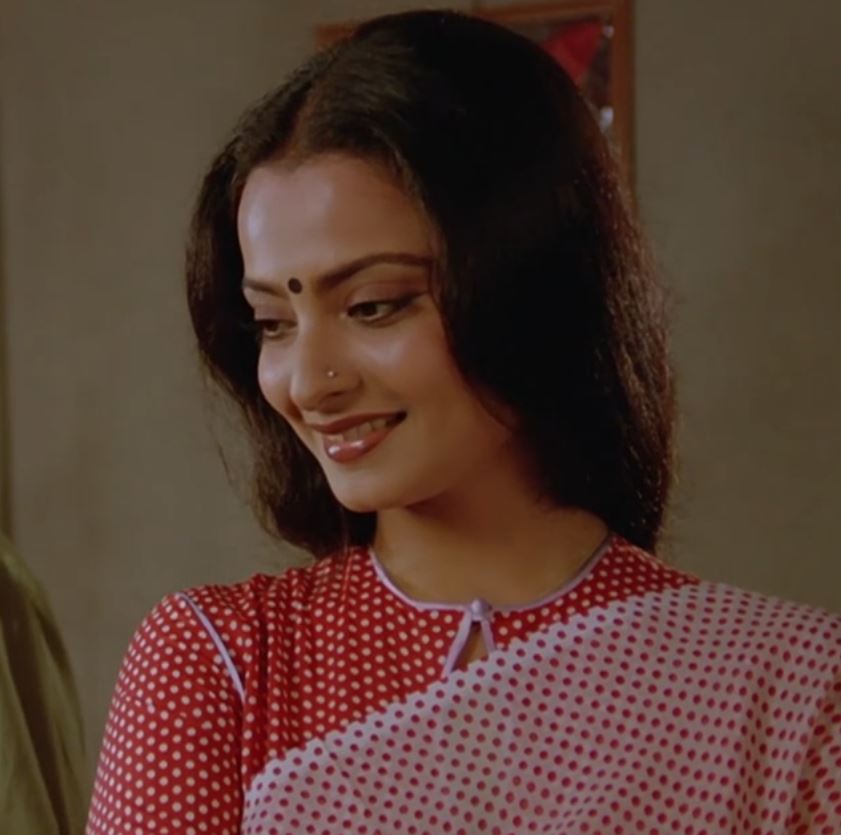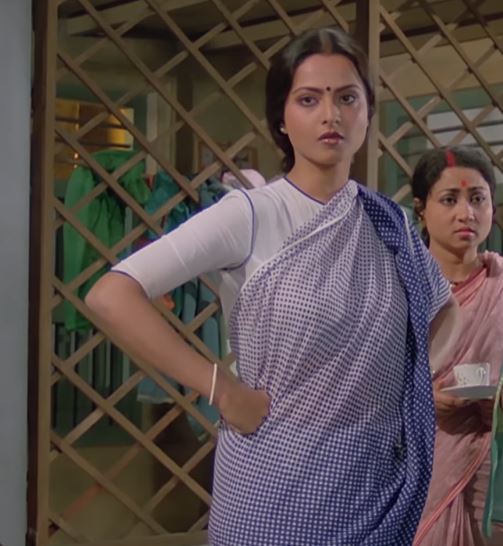Today let’s look at Rekha’s commitment to the polka dot – with a side serving of leheria (diagonal stripes or literally waves)! As with Vijeta, the look is very consistent, bar a “dream sequence” and a wedding.
The movie: 1982’s Jeevan Dhaara. Bit of a three hanky movie about the travails of the breadwinner of a large family. Remade from the Tamil Aval Oru Thodar Kathai (which has some interesting wardrobe choices of its own). Most of what follows is a working woman’s wardrobe – the everyday curated and modified for a star but still faithful to the character.

First up the 200% all polka dot starter!
The template for Rekha’s sarees in the movies is a saree with a thin border/piping with the colours inverted for the blouse, which too has piping (in general you see a fair bit of piping in 1980s Rekha sightings). When it is the saree that is plain – as here – the pallu mirrors the polka dot blouse. The blouse remains more or less the same, high-necked with a keyhole fastened with a closure. All completely colour co-ordinated and usually employing two colours.
Almost throughout the jewellery is simple studs and a small nose ring and finger rings.
The 70s and 80s were big on matching glass bangles and this movie is no exception.
I can’t figure out if the saree material is terene but it is one of the synthetics available then, albeit not the sheer, flowered polyesters that were popular in the latter part of the decade.
Here the saree has polka dots. Again the colour palette is restricted to two colours, Everything else is similar except that the saree doesn’t have a separate pallu. In general all patterned sarees in the movie do not feature a pallu.
The hair is usually a plait with a sleek middle parting . But the at home scenes feature Rekha’s signature cloud of hair.
Another plain saree/polka dot blouse combo. The polka dots are almost invisible but they are there:) Note the watch – a staple back in time to denote the working woman. Also note the room decor – the basics of a lower middle class home.
Again a similar template. Soft colours but bolder polka dots. As also hoop earrings.
This is a little different in using the same template with three colours. Also note the white clutch.
A bit of a variation here in having a flowered section of the saree, Also note the Kolhapuri chappals.
A couple of the sarees and blouses feature leheria. Generally two colours but also employs three when the blouse is patterned. You will note that the design and styling is consistent with the polka dot ensembles.
If you note carefully, with a few exceptions where the keyhole closure button is contiguous with the piping, it usually picks up the blouse colour thus providing a tiny visual contrast to the piping.
And lastly the shaded/ombre leheriya and polka dot sarees:)
Jeevan Dhaara is truly an example of how to style with a few elements, maintain a consistent look and provide a rich variety. The variety is all in the details and this is practically a collection of its own. I doff my non-existent hat to the team that designed it (see below) as well as the ever glorious Rekha who brings it all to life and more.

Above via imdb.
































